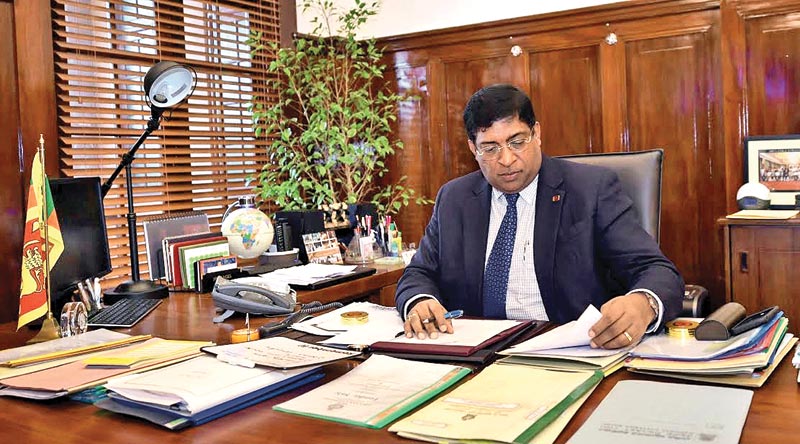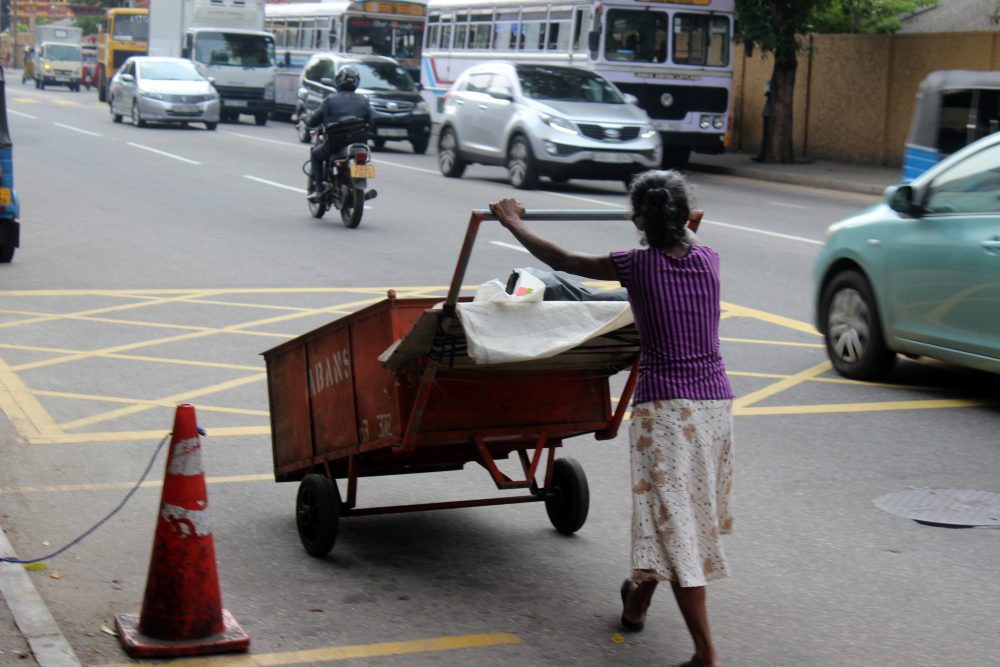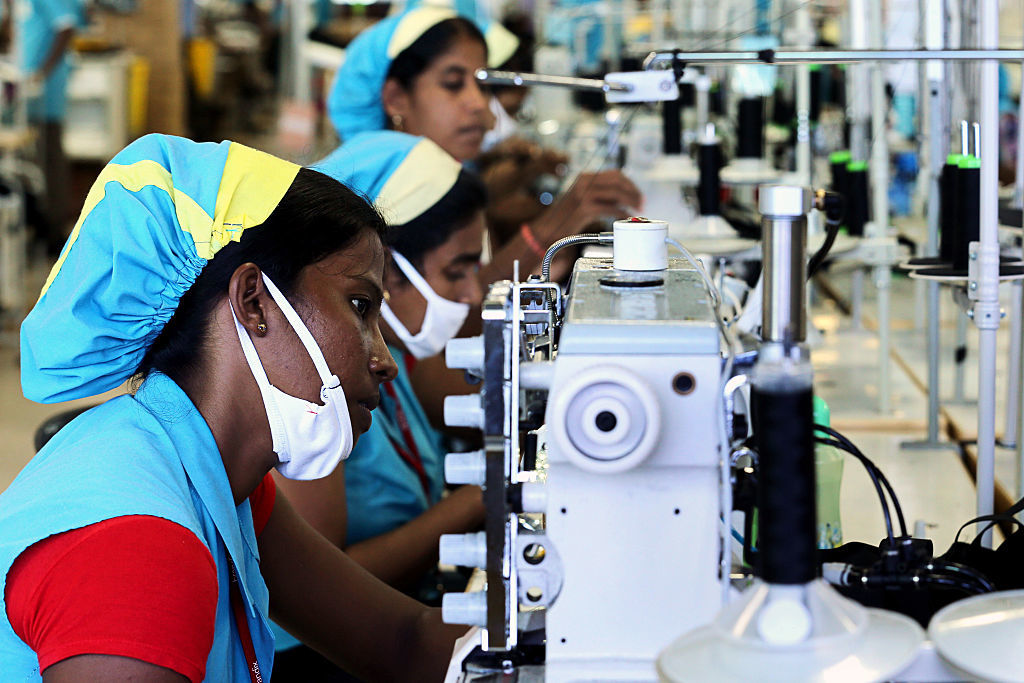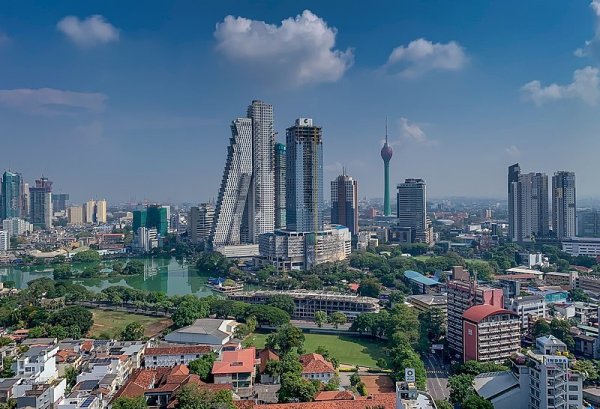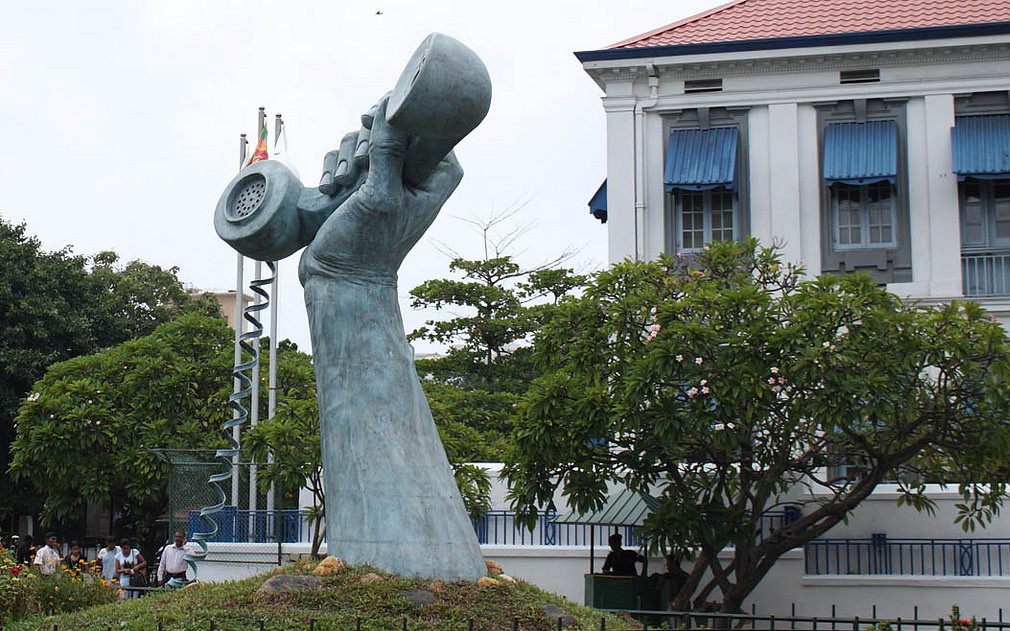
Strikes and protests by ‘manpower’ workers in the state sector are not unheard of in Colombo. However, recent trade union action connected to Sri Lanka’s leading telecommunications provider and the alleged abduction of a union leader have largely flown under the radar, despite grave implications.
Since Boxing Day last year, over 800 ‘manpower’ workers employed by SLT Human Capital Solutions (HCS) and outsourced to Sri Lanka Telecom (SLT) have staged a continuous strike. At the time of writing this article, the strike is on day 44. While SLT’s management refuses to comment on the issue, union leaders claim that within another two weeks SLT’s operations could be crippled.
Meanwhile, police investigations are ongoing with regard to the alleged abduction of union leader Sujeewa Mangala. Mangala, who is the Vice President of the All Ceylon Telecommunications Employees Union (ACTEU), claims to have been abducted by armed men, held captive, and told to give up the strike, before finally being dropped off blindfolded on the side of the road after two days.
Although the mainstream media has remained largely silent on this issue, the trade unions haven’t. Veteran union leader Ceylon Mercantile Union President Sylvester Jayakody told Roar that he plans to take this case to the International Labor Organisation, while SLT authorities remain tight-lipped as ever. In light of all this, now is as good a time as any to examine the history of the conflict at SLT, and the broader issues regarding manpower.
What Is Manpower?
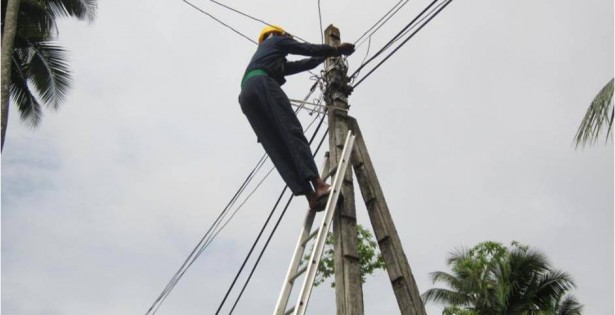
SLT’s manpower workers range from lower level technicians to mid-level assistant engineers. Image courtesy: accessengsl.com
According to Balasingham Skanthakumar, a researcher at the Social Scientists Association, “Manpower is a mechanism for the supply of labour from one party to another.” Manpower workers are essentially contract workers attached to an agency. A user company ‒ like Sri Lanka Telecom ‒ may approach such an agency to source labour for roles that are supplementary to their core operations, hard to fill, and somewhat temporary in nature.
The practice of relying on manpower agencies for labour is relatively recent according to Skanthakumar, dating back to the late 1990s and early 2000s. He speculates: “The 2002-2004 Government of the UNP and the People’s Alliance was committed to a reduction in the public sector workforce in order to fulfil conditionality for loans from the IMF and World Bank. It is at this time that manpower became more mainstream as it allowed the public sector to cease hiring permanent staff.”
Indeed, the practice of manpower has become so widespread today that manpower workers make up a significant share of the total cadre of workers in a number of State institutions including the Ceylon Electricity Board, Water Supply and Drainage Board, Sri Lanka Ports Authority, and Bank of Ceylon to name a few. At Sri Lanka Telecom, which the state owns a 52.87% share in, manpower workers make up around 30% of all workers and range from lower level technicians to mid-level assistant engineers.
Double Standards
What has lead to conflict in this context is the fact that an increasing number of manpower workers are being relied on to do work that is continuous in nature, and often part of the core operations of the user company, says Skanthakumar. In a nutshell, manpower workers are doing the same work as permanent employees but reap significantly different rewards.
The most obvious grievance of manpower workers is that they are generally paid less. This is largely due to the fact that the user company does not pay manpower workers directly. Instead, negotiations are made between the manpower agency and the user company. Once the agency is paid for its services, it keeps a commission for itself before distributing wages to workers. Furthermore, manpower workers are generally not entitled to the same benefits and privileges as their permanent counterparts.
According to a letter sent from by the All Employees Union of Information and Telecommunication (AEUIT) to the Minister of Labour and Trade Union Relations, SLT employees are entitled to an annual bonus of Rs. 180,000 and an overtime rate of Rs. 320 per hour, compared to HCS workers’ bonus of Rs. 80,000 and overtime of Rs. 170. In addition, SLT permanent staff are entitled to a food and transport allowance of Rs. 14,000, a monthly medical allowance of Rs. 1,000, an annual allowance for medical tests of Rs. 7,000, a relief housing loan of Rs. 1,000,000 and a bicycle purchasing loan of Rs. 400,000. HCS workers are not entitled to any of these.
Joint Secretary of the AEUIT, Prahbhath Lankaloka, puts it like this: “HCS manpower workers at work alongside the SLT permanent staff on the same premises and under the same supervision. They undergo the same training and perform the same tasks. They even use the same fingerprint scanner to check-in. The only difference is that one group of workers has less rights.”
Human Capital
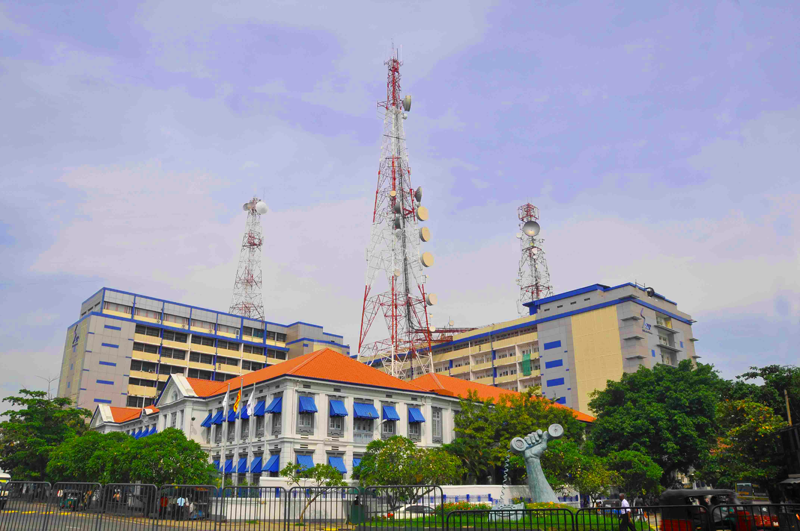
The offices of Sri Lanka Telecom. Image courtesy srilankabrief.org
Sri Lanka Telecom began recruiting workers through private manpower agencies as far back as the late 1990s and early 2000s, according to various union sources. This means that some of the manpower workers protesting today have been working at SLT for well over a decade – not exactly temporary work.
In 2007, Sri Lanka Telecom took matters into its own hands by creating its own manpower agency called SLT Manpower Solutions Pvt. Ltd. ‒ renamed SLT Human Capital Solutions Pvt. Ltd. (HCS). This private entity is a subsidiary that is 100% owned by SLT, according to their website.
SLT absorbed all of its prior contract workers under this new subsidiary, and continued hiring new contract workers through it. Some workers continued to fill roles at SLT, while others were outsourced to other user companies. The legal gymnastics at play meant that despite fully owning the manpower agency, SLT is able to argue that workers at HCS are not their direct employees and therefore not eligible for the same salaries and benefits.
A letter sent by the AEUIT to the Ministry of Labour estimates that from 2009 to 2015 the number of direct employees at SLT grew from 6,631 to 7,824, in tandem with the company’s 18% growth rate. However, the AEUIT claims that by the end of 2015 this number had dropped to 5,761 and that the numbers of employees supplied through HCS had grown to 2,165. Thus, the union argues that SLT has replaced its permanent cadres with cheaper manpower labour.
Broken Strikes, Broken Promises
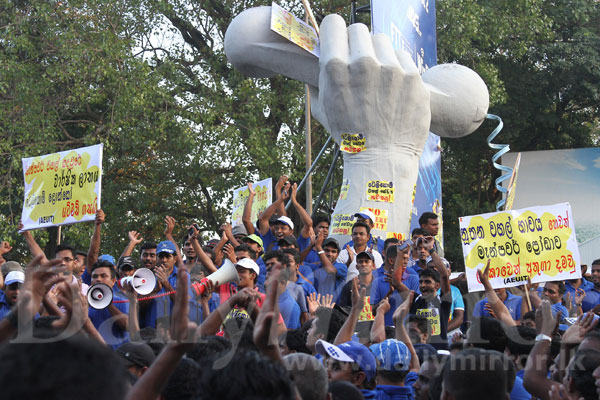
Manpower workers at HCS have launched intermittent strike action since the last regime. Image courtesy: Daily Mirror
In December 2014, during the last month of the Rajapaksa regime, workers affiliated with AEUIT initiated a strike. The management of SLT responded in court, arguing that the strike was preventing it from carrying out its functions. The AEUIT says it was ultimately slapped with an injunction prohibiting future strikes.
The emergence of Maithripala Sirisena as common candidate shortly before this offered workers a glimmer of hope. In the lead-up to the presidential elections of January 2015, AEUIT claims that representatives of Sirisena promised workers a swift resolution to the issue. Following his election, however, there was little change aside from the controversial appointment of his brother Kumarasinghe Sirisena as Chairman of Sri Lanka Telecom.
However, budget proposals for 2015, which were approved by Parliament in December 2014, contained a clause that could have seemingly put the matter to rest once and for all. Clause 57.2 states: “ I also propose to create the required cadre positions to absorb all casual employees who have been in employment for over 180 days in public corporations and statutory agencies.”
The AEUIT has argued since, that the proposal should apply to SLT manpower workers because 52.87% of SLT’s shares are owned by state bodies (as at March 31, 2016) like the Secretary to the Treasury and the Employees Provident Fund.
Fast forward to May 2016 and a lack of progress on the issue lead to yet another strike, according to AEUIT leaders. Citing the 2014 injunction barring the AEUIT from striking, SLT reportedly argued that the actions of the union qualified as contempt of court and launched a civil case against it, effectively crippling the functioning of the AEUIT.
A few months later, SLT manpower workers regrouped and reorganised themselves under a new union – the All Ceylon Telecommunications Employees Union (ACTEU) ‒ with the full blessing of the AEUIT. Under this new banner, three workers took to protesting at the top of the SLT communications tower in October. Then, on Boxing Day last year, around 800 manpower workers launched a fresh strike that has continued now for over 40 days.
Black Van

Sri Lanka’s infamous white van abductions could be back in black. Image courtesy: economynext.com
Roar had arranged for a face to face interview with Sujeewa Mangala, Vice President of the ACTEU to discuss his alleged abduction. However, Mangala declined to appear on the day, sending his peers from ACTEU in his stead. Over a brief phone call, Mangala later said: “I’m tired of talking to people about the abduction. No one was interested when we were striking until what happened to me.”
According to accounts recanted by his peers and found in media reports, Mangala was driving his motorbike home alone after midnight on Sunday, January 28. While he was driving through the rain, a black van reportedly followed Mangala before abruptly overtaking him and blocking his path. Three masked men, armed with pistols, then proceeded to exit the vehicle and force Mangala inside. There were two more masked men inside the vehicle, one of whom was the driver.
Mangala claims he had his hands tied behind his back and his vision obstructed with a bag draped over his head. He said that he briefly heard one of the abductors make a phone call to say: “The job is done”. After what he estimates to be a three-hour ride, Mangala was escorted to a room and held captive for two days. During this time, he was given food and access to toilet facilities but no mattress to sleep on. He says he was not tortured but was asked to give up the strike and mind his own business.
Mangala was later found blindfolded and dumped on the side of the road in Ingiriya in the early hours of the 1st of February.
ACTEU members told Roar that Mangala and a few other union leaders often work into the early hours of the morning and that there are chances that Mangala himself wasn’t specifically targeted. Rather, they speculate that the abductors waited for the chance to capture any leader who happened to be alone that night.
Negotiations
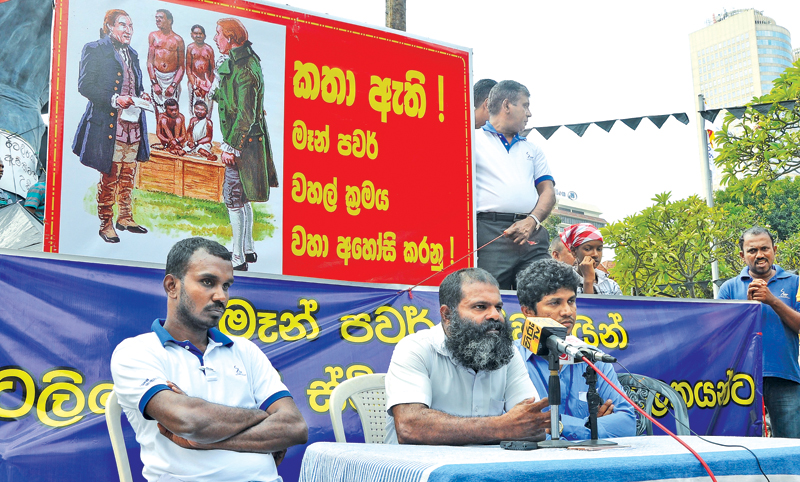
ACTEU representatives discuss manpower grievances at a rally. Image courtesy: Daily News
Manpower workers and the unions that represent them have consistently put forward one key demand: for HCS contract workers to be fully absorbed into SLT as part of the permanent cadre.
“SLT spends millions every day on lawyers to take workers and unions to court. They clearly have the resources to make these workers part of their permanent cadre,” argues AEUIT Joint Secretary Lankaloka. “By preventing workers from striking, SLT have tacitly admitted that manpower workers are essential to the functioning of SLT, so why not treat them as such?”
A circular outlining new prerequisites for permanent employment was released by SLT on December 31, 2015. Among these was the requirement that applicants have a minimum of seven years work experience and be under the age of 35. Both ACTEU and AEUIT members, however, argue that many of those who have put in seven years of work at HCS would now be above the age of 35, thus being ineligible for recruitment.
The clock seems to be ticking when it comes to the SLT management’s dealing with manpower workers. Around July last year, Minister of Labour and Trade Union Relations, W. D. John Seneviratne, recommended that manpower workers at SLT be absorbed as permanent employees provided they have the requisite qualifications. Later in the year, Secretary to the Minister of Telecommunication and Digital Infrastructure, Wasantha Deshapirya, suggested much the same.
When contacted by Roar for a comment, President Sirisena’s brother and Chairman of Sri Lanka Telecom, Kumarasinghe Sirisena, refused to acknowledge the manpower issue, arguing: “This is not a strike by Sri Lanka Telecom employees, but by workers at a different subsidiary. It does not concern or affect us.”
When questioned about manpower workers’ allegations of doing the same work as permanent employees and their demands to be absorbed into the company’s permanent cadre, he responded: “This cannot happen because they work for a separate subsidiary, not for Sri Lanka Telecom. Whatever they are demanding is a part of their business strategy.”
The Chairman went on to emphasise that the strike was not affecting the operations of SLT before declining to comment further.
Roar also reached out to CEO of Human Capital Solutions, Roshan Kaluarachchi, and Minister of Telecommunications and Digital Infrastructure, Harin Fernando, to comment on the issue, but neither were available to respond in time.
Regulation Or Revolution

Many protesters and trade unionists demand the abolishment of manpower. Image courtesy: Daily Mirror
Perhaps the more radical demand from protestors, is the demand to abolish the practice of manpower entirely. AEUIT Joint Secretary Lankaloka argues that without the total abolishment of manpower agencies, there is nothing stopping companies like SLT from continuing to recruit contract workers even after absorbing the current cadre into permanent employment.
“Manpower is quite simply a form of modern day slavery where workers are compensated with less than what they deserve for the work that they do. They are burdened with precarity and insecurity which affects their standard of living,” says Lankaloka.
SSA Researcher Skanthakumar is sympathetic to these demands but argues that the underlying issues go far deeper. “The difficulty about thinking of abolishment now is that it does nothing to address widespread exploitative work arrangements. Until the goal of securing full and decent employment for all is achieved, such issues will continue,” he says.
This is not to say that work cannot be done in the medium to short term, however. From a regulatory standpoint, there is much ground to be covered, in tandem with or in place of demands for abolition.
Says Skanthakumar, “We need to have legislation that specifically pertains to manpower agencies. We need to set out the scope of operations of these agencies and define their responsibilities to both the state and the worker. Things like annual registration, certification, auditing of accounts, and frequent inspections can help curb the problem.”
Whatever the demands put forward by workers and their trade union representatives, a workable solution seems far from the horizon. However, the stakes at Sri Lanka Telecom are such that, whatever solution is eventually arrived at will likely set the precedent for how future manpower conflicts are resolved in the country.
Featured image credit: Lasith Lansakara/discovering serendipity

